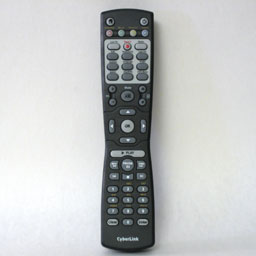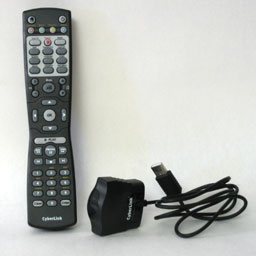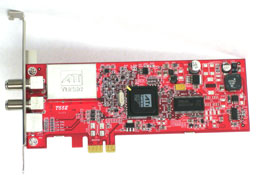HTPC - TV Tuner Reviews
by Jarred Walton on December 7, 2005 12:05 AM EST- Posted in
- Smartphones
- Mobile
PowerColor Theatre 550 Pro PCIe
The last card that we're looking at is quite a bit different from the other two. It's one of the first truly interesting PCI Express X1 cards for home users. (LAN and SATA cards might interest higher end buyers, but most people don't need to worry much about that.) Given the number of boards that are only shipping with two or three PCI slots, plus one to three PCIe X1 slots, it's nice to finally be able to put the PCIe slots to use. Now, if only someone would get around to releasing a PCIe sound card... but I digress. PowerColor is the first to market with a PCIe TV Tuner, based on the ATI Theater 550 (or "Theatre 550" if you prefer the PowerColor/British spelling, though we'll stick with Theater).
The PowerColor card is obviously inferior to the other cards in a few ways. No HDTV support is going to disappoint many people, and no QAM decoding also limits its versatility. As we've mentioned already, though, there's a big difference between doing something, and doing it well. If the analog support on the Theater 550 is clearly superior to that of the other cards, the lack of other features may not matter. We looked at analog TV Tuners several months ago, and in that roundup, the ATI Theater 550 came out on top. With the main difference being PCIe vs. PCI, hopefully we won't see any change in quality.
Something else to consider is that there are no PCIe HDTV tuners at present. With most recent motherboards only including two or three PCI slots, you could put an HDTV tuner in one of those slots and place an analog tuner in an X1 slot. Assuming that you have an add-in sound card, you may not have enough PCI slots to fully accommodate your HTPC needs. The maximum number of supported tuners under Windows MCE is four: two HD and two analog. Most people probably don't go that extreme (and good luck getting a clean signal if you split a coaxial input more than four ways), but it's still something to consider.
Besides the card, you once again get a remote, a USB infrared receiver, and a software bundle. There's also an input cable that allows the use of S-VIDEO or Composite sources, and you get an FM antenna and input. (Radio reception is as bad as OTA TV reception, so I didn't bother trying it. I'm not much of a radio listener anyway.) The remote is definitely more attractive than the Fusion remote, but the MyHD remote is still the smallest of the three. As with the Fusion remote, be careful of the power button, as you can accidentally shut down the PC (or put it in suspend mode) rather than just turning off the software interface. To shut down PowerCinema, you actually press the "Home" button twice. (Duh - as if that's not totally clear....) The placement of the power button on the remote makes it easier to hit, unfortunately, and on several occasions I forgot to use the Home/Power button. Some people may like the feature, but we generally just leave HTPCs running and found it to be more annoying than anything.
The software bundle of the PowerColor card is quite extensive. You get a large selection of CyberLink products with the package, and while several are "Lite" versions, they'll still suffice for most people: PowerDVD, PowerProducer DVD, PowerDirector SE+, Power2Go, MediaShow SE, and PowerCinema. Will you actually need most of that software? Probably not, but it doesn't hurt to have it. Also note that the remote is technically from CyberLink and is made to work with the above software, so if you were to purchase a different Theater 550 card, you would get some other remote. The remote is MCE compliant, though, so you can use it with either interface.
The last card that we're looking at is quite a bit different from the other two. It's one of the first truly interesting PCI Express X1 cards for home users. (LAN and SATA cards might interest higher end buyers, but most people don't need to worry much about that.) Given the number of boards that are only shipping with two or three PCI slots, plus one to three PCIe X1 slots, it's nice to finally be able to put the PCIe slots to use. Now, if only someone would get around to releasing a PCIe sound card... but I digress. PowerColor is the first to market with a PCIe TV Tuner, based on the ATI Theater 550 (or "Theatre 550" if you prefer the PowerColor/British spelling, though we'll stick with Theater).
The PowerColor card is obviously inferior to the other cards in a few ways. No HDTV support is going to disappoint many people, and no QAM decoding also limits its versatility. As we've mentioned already, though, there's a big difference between doing something, and doing it well. If the analog support on the Theater 550 is clearly superior to that of the other cards, the lack of other features may not matter. We looked at analog TV Tuners several months ago, and in that roundup, the ATI Theater 550 came out on top. With the main difference being PCIe vs. PCI, hopefully we won't see any change in quality.
Something else to consider is that there are no PCIe HDTV tuners at present. With most recent motherboards only including two or three PCI slots, you could put an HDTV tuner in one of those slots and place an analog tuner in an X1 slot. Assuming that you have an add-in sound card, you may not have enough PCI slots to fully accommodate your HTPC needs. The maximum number of supported tuners under Windows MCE is four: two HD and two analog. Most people probably don't go that extreme (and good luck getting a clean signal if you split a coaxial input more than four ways), but it's still something to consider.
 |
 |
| Click to enlarge. | |
Besides the card, you once again get a remote, a USB infrared receiver, and a software bundle. There's also an input cable that allows the use of S-VIDEO or Composite sources, and you get an FM antenna and input. (Radio reception is as bad as OTA TV reception, so I didn't bother trying it. I'm not much of a radio listener anyway.) The remote is definitely more attractive than the Fusion remote, but the MyHD remote is still the smallest of the three. As with the Fusion remote, be careful of the power button, as you can accidentally shut down the PC (or put it in suspend mode) rather than just turning off the software interface. To shut down PowerCinema, you actually press the "Home" button twice. (Duh - as if that's not totally clear....) The placement of the power button on the remote makes it easier to hit, unfortunately, and on several occasions I forgot to use the Home/Power button. Some people may like the feature, but we generally just leave HTPCs running and found it to be more annoying than anything.
The software bundle of the PowerColor card is quite extensive. You get a large selection of CyberLink products with the package, and while several are "Lite" versions, they'll still suffice for most people: PowerDVD, PowerProducer DVD, PowerDirector SE+, Power2Go, MediaShow SE, and PowerCinema. Will you actually need most of that software? Probably not, but it doesn't hurt to have it. Also note that the remote is technically from CyberLink and is made to work with the above software, so if you were to purchase a different Theater 550 card, you would get some other remote. The remote is MCE compliant, though, so you can use it with either interface.











77 Comments
View All Comments
Brian23 - Thursday, December 8, 2005 - link
I'm supprised more people aren't talking about this. I haven't downloaded them, but I assume they are recordings of OTA broadcasts. If that's the case, then I'm suprised Anandtech posted them. In the news section they're always posting stuff about how people are getting sued for sharing movies. Most of the movies out there on torrents have been broadcast OTA at some point which would make them public domain. Everyone is so quick to judge someone when they post a torrent of something, but mysteriously no-one has said anything about this yet.JarredWalton - Thursday, December 8, 2005 - link
They're basically 30 second clips demonstrating analog/HDTV videos. If anyone wants to come after me for posting sample content... wow, they have way too much time on their hands. I guess I didn't bother to get "express, written consent" though....Brian23 - Thursday, December 8, 2005 - link
I don't fault you for posting this, and I don't think you need express written consent. I think the whole lawsuit thing over p2p file sharing is a bunch of crap. My point I was trying to make in my previous post was that I was suprised that no-one was was posting anything about copywrite violations. Normally the people here at Anandtech scream and yell if there's something being distributed that's copywritten, no matter what it is. I think people should be able to share stuff that they recorded from OTA.valnar - Wednesday, December 7, 2005 - link
Perhaps I missed something in the review, but what's the point of posting screen shot comparisons of a transport stream? They would all be identical across all the cards, unless there were bit errors in the stream. Of course they all look good! They should also look the same too. The only way to show a difference would be through a video card, such as a particular ATI or nVidia in either overlay or VMR9 mode. Or with the hardware output of the MyHD series of cards, which is vastly superior to the software based cards. If you have an HDTV and have used the DVI or Component out of the MDP-1xx, they are fantastic. Of course, a screenshot wouldn't show that. Maybe a digital photo or something(?).It should also be noted that watching HDTV on overlay is a big no-no. The overlay was never meant to register more than 540 lines of resolution. While deciding between overlay or VMR9 for DVD (740x480/NTSC) watching is a matter of religious debate, overlay can never resolve HD properly. I would submit that the reviewer possibly didn't see any of those cards in their full glory.
-Robert
xtknight - Wednesday, December 7, 2005 - link
Where is this overlay limitation stated and what happens when you go above said lines? I'm sorry but I find that hard to believe. SIL overlay vs. SIL VMR9 looks the exact same to me as I remember it. What does 540 lines mean? What resolution is the max (x by y)?JarredWalton - Wednesday, December 7, 2005 - link
I'm a little confused by this overlay limitation as well. I mean, obviously the Fusion5 only works through overlay, but the video stream is transferred digitally from the TV Tuner to the graphics card. There should be no limitation other than bandwidth, I thought? Maybe I'm using the term "overlay" incorrectly here?As for the HD images, I mentioned that they are all identical for TP captures. They were included to show people exactly how much data HDTV contains (and how much better looking HDTV is) relative to analog/SDTV. The upsampled SDTV image is also there to show how poor that looks in comparison to a real HDTV stream - and I get far too much upsampled content on most HD channels.
valnar - Thursday, December 8, 2005 - link
These limits are discussed in all the usual forums, like avsforum.com.JarredWalton - Thursday, December 8, 2005 - link
Link please? I just don't see how the hardware overlay interface on your video card could possibly be limited to only 720 x 480. Windows Media Player uses the overlay mode for playing video. Last I checked, it's fully capable of playing 1080I resolution. NTSC signals have nothing to do with overlay mode inside computers.valnar - Thursday, December 8, 2005 - link
It not limited per se, but you won't see much of an improvement at a rez above 540 lines horizontal. Everything (like WMP) can use the Overlay, but if you were to truly show a video in 1080P mode, for example, it wouldn't be as sharp - because of most video card overlay limitations. It's hard to explain, as the resolution of overlay is more an "analog" style of limitation, to use that metaphor inaccurately. It simply doesn't resolve the detail of HDTV, period. Get a 100" screen and a projector and it becomes obvious. Forgive me for not being able to articulate it, hence my recommendation to visit Home Theater/HTPC specific forums.xtknight - Thursday, December 8, 2005 - link
I can't find anything about this limitation with google or avsforum search. Are you mixing up overlay with interlacing? It would be nice if you could provide us with a link because we effectively have no clue what you're talking about here...